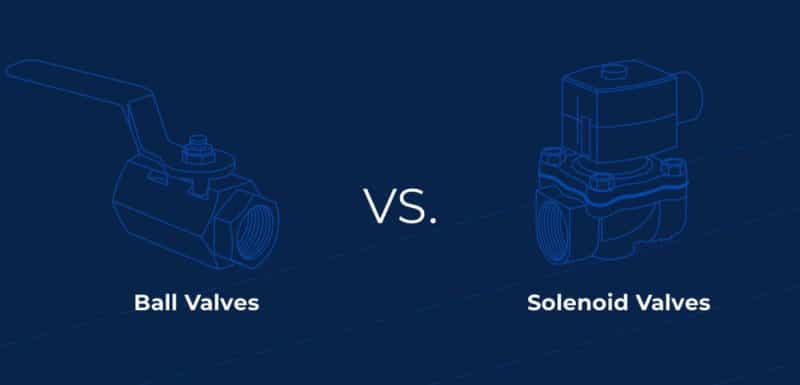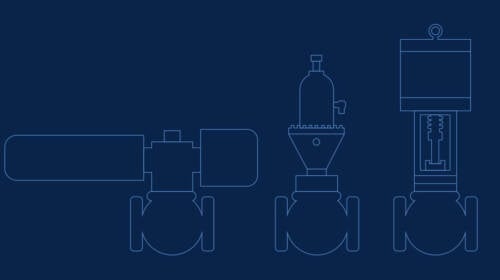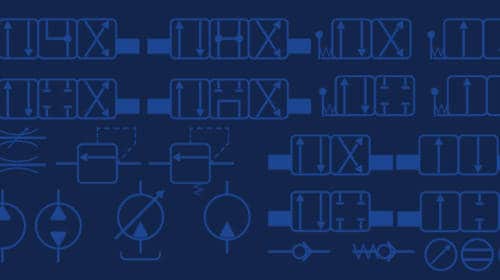Solenoid Valves vs. Ball Valves

Both solenoid valves and ball valves are on/off valves that work to control the flow of fluid through a piping system. While they serve similar functions, there are important distinctions to consider when determining which valve type is best for your specific application. Read on to learn about the differences between solenoid and ball valves, plus suitable applications, advantages and disadvantages of each valve type.
What Is a Solenoid Valve?
A solenoid valve is an electrically powered shut-off valve often used to facilitate the transport of clean liquids and gasses. Just as the name suggests, the key component of a solenoid valve is a solenoid — an electric coil with a moveable magnetic plunger in the center.
These fast-acting valves work by way of electromagnetic energy. When at rest, the magnetic plunger closes off a small orifice. When powered by an electric current, a magnetic field is generated, exerting force upon the solenoid’s plunger. This causes the plunger to move in an upward motion, opening the port in the process.
Solenoid valves are a top choice for manufacturers, as they can control the release, distribution and mixing of fluid, air and gas with fast cycle times. Their capacity to work with various materials makes them a versatile valve option that can be used in many different applications.
There are three main types of solenoid valves:
2-way Solenoid Valve:
-
- Includes an inlet and outlet linked to the flow source
- Offers only two options: open or closed
- Closes to stop fluid media, opens to allow media flow
3-way Solenoid Valve:
-
- Contains three ports
- Includes three control settings: normally closed, normally open and general
- Is capable of diverting media through different ports
4-way Solenoid Valve:
-
- Functions as a double-acting cylinder
- Is equipped with one or two exhaust ports, two-cylinder ports, a pressure port and multiple connectors
Solenoid valves are used in various industries and systems that require highly responsive on-off controls, with a few of the most common including:
-
- Heating
- Compressed air
- Vacuum
- Irrigation
- Car washes
Solenoid valves are also used to control other pneumatically actuated valves such as pneumatically actuated ball valves. Some ball valve manufacturers will offer integral solenoid valves with their pneumatic actuators. The solenoid valve serves to divert the compressed air to the appropriate port on the pneumatic actuator when signal voltage is introduced.
What Is a Ball Valve?
Like solenoid valves, ball valves are on/off valves that control the flow of media through a piping system. However, unlike a solenoid valve, a ball valve uses a rotary ball and spherical bore to restrict or allow the flow of liquid, gas or air when the ball component is rotated 90 degrees. Ball valves are available in manual and automatically actuated options and with a variety of pipe connection types.
Ball valves are popular because of their long service life and reliability, even when exposed to contaminated substances. Ball valves are also favored in certain applications where the media contains particulates. The wiping motion of the ball across the seats serves to clear away particulates and debris, which can cause issues with many other types of valves. Although ball valves are generally considered on/off valves, they can sometimes be used as control valves when equipped with a v-port ball.
When to Use a Solenoid Valve vs. a Ball Valve
When determining whether a solenoid valve or a ball valve is more suitable for your piping system or application, consider the following key factors:
Actuation: Actuation is the method by which a valve is powered; solenoid valves are powered by an electric current and magnetic field, while a ball valve can be powered manually, pneumatically, hydraulically or electrically.
Size: Ball valves have fewer size limitations, but either valve type can be suitable if you require a valve port size of two inches or smaller.
Speed: Solenoid valves and pneumatically actuated ball valves typically have a faster response time; electrically-actuated ball valves are relatively slow when opening and closing.
Cycle Life: In general, ball valves last significantly longer than solenoid valves.
Operating Pressure: Ball valves can withstand much higher levels of pressure than solenoid valves.
Materials: Solenoid valves tend to be made mostly from stainless steel and brass, while ball valves are available in many different options, including bronze, carbon steel, stainless steel, PVC, Polypropylene and so on. Since ball valves come in a variety of material compositions, they may be suitable for a wider range of applications.
Media: Ball valves are a better choice for media with particulates. These can get stuck in solenoid valves and cause clogs, whereas with ball valves, the wiping motion of the ball against the seats tends to clear out debris.
Failure Needs: While both solenoid and ball valves are available with fail-safe design options, solenoid valves are a less expensive option in many fail-safe applications.
On-off versus modulating control: Both solenoid valves and ball valves are typically used for on/off control only. However, when equipped with a v-port ball and a modular actuator, ball valves can be used in some control applications.
Pros & Cons of Solenoid Valves
When you need to select a valve for your next project, it is crucial to weigh the advantages and disadvantages of each valve type. Review the chart below to explore the pros and cons of solenoid valves.
Solenoid Valve
| Advantages | Disadvantages |
| Compact size; lightweight | Pressure limitations depending on size and design |
| Fail-safe design (normally-closed or normally-open) | Lower flow than some other valve types |
| Extremely high cycle life | No manual override |
| Very fast-acting | Rapid closure can lead to water hammer |
| Can operate using AC or DC power | Certain forms of media can cause clogs |
| Lower upfront costs |
Pros & Cons of Ball Valves
While ball valves can be suitable in a variety of applications, they also have some limitations that you should consider before using a ball valve in your piping system. Review the information below to explore the pros and cons of ball valves.
Ball Valve
| Advantages | Disadvantages |
| Very high flow rate potential with low pressure drop | Electric actuated models are slower acting than solenoid valves |
| Available in manual and motorized, hydraulic pneumatic options | Bulkier than solenoid valves |
| Can withstand high inlet and back pressures | Electric actuator versions can become overheated and require a minimum off time |
| Air-actuated versions include fail-safe design | Electric actuator versions do not typically include fail-safe design |
| Explosion-proof options available | High flow capacity can lead to water hammer |
Solenoid valves and ball valves each have their pros and cons, and Gemini Valve often sees potential customers looking for automated ball valves in applications where solenoid valves have prematurely failed. For example, some of our customers have found that solenoid valves failed prematurely in applications where the media flowing through the valve contained particulates.
If you need help selecting the most suitable valve for your piping systems and applications, contact Gemini Valve today. Our experts have the knowledge and experience needed to ensure you make the right choice.
Valve Sizing 101: Your Blueprint for Effective Flow Management
Discover how strategic valve selection impacts flow control processes.




